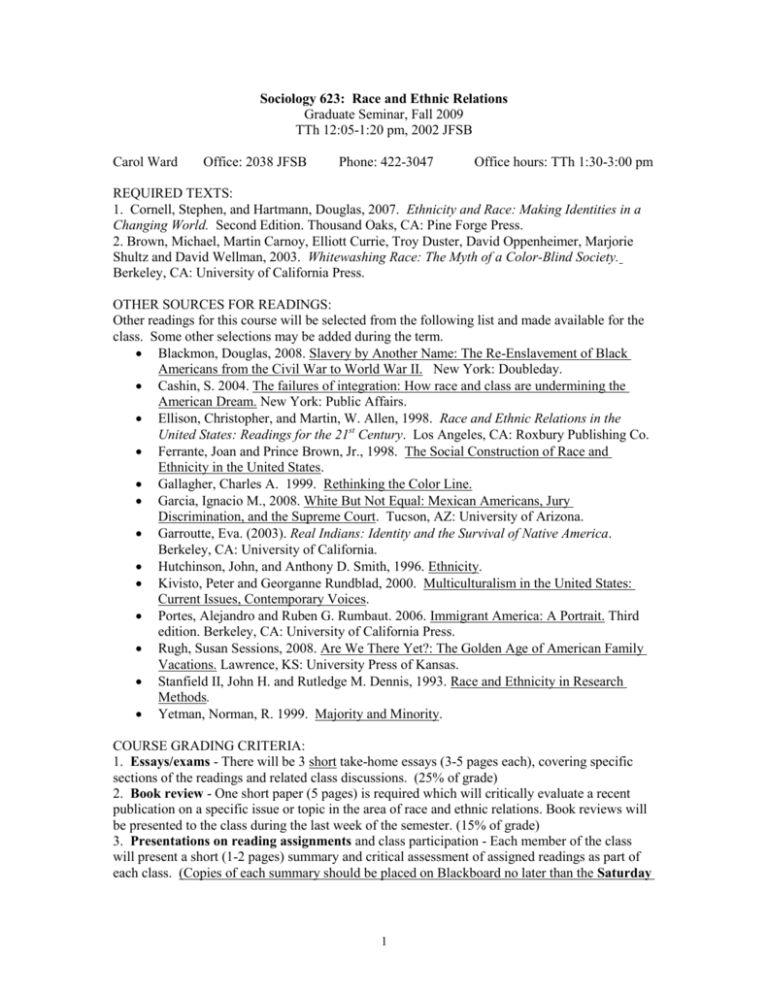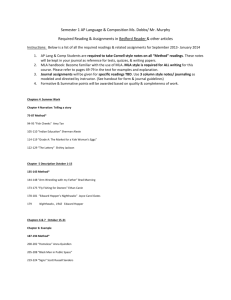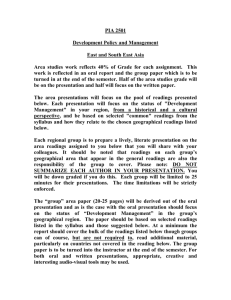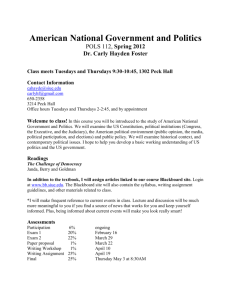
Sociology 623: Race and Ethnic Relations
Graduate Seminar, Fall 2009
TTh 12:05-1:20 pm, 2002 JFSB
Carol Ward
Office: 2038 JFSB
Phone: 422-3047
Office hours: TTh 1:30-3:00 pm
REQUIRED TEXTS:
1. Cornell, Stephen, and Hartmann, Douglas, 2007. Ethnicity and Race: Making Identities in a
Changing World. Second Edition. Thousand Oaks, CA: Pine Forge Press.
2. Brown, Michael, Martin Carnoy, Elliott Currie, Troy Duster, David Oppenheimer, Marjorie
Shultz and David Wellman, 2003. Whitewashing Race: The Myth of a Color-Blind Society.
Berkeley, CA: University of California Press.
OTHER SOURCES FOR READINGS:
Other readings for this course will be selected from the following list and made available for the
class. Some other selections may be added during the term.
Blackmon, Douglas, 2008. Slavery by Another Name: The Re-Enslavement of Black
Americans from the Civil War to World War II. New York: Doubleday.
Cashin, S. 2004. The failures of integration: How race and class are undermining the
American Dream. New York: Public Affairs.
Ellison, Christopher, and Martin, W. Allen, 1998. Race and Ethnic Relations in the
United States: Readings for the 21st Century. Los Angeles, CA: Roxbury Publishing Co.
Ferrante, Joan and Prince Brown, Jr., 1998. The Social Construction of Race and
Ethnicity in the United States.
Gallagher, Charles A. 1999. Rethinking the Color Line.
Garcia, Ignacio M., 2008. White But Not Equal: Mexican Americans, Jury
Discrimination, and the Supreme Court. Tucson, AZ: University of Arizona.
Garroutte, Eva. (2003). Real Indians: Identity and the Survival of Native America.
Berkeley, CA: University of California.
Hutchinson, John, and Anthony D. Smith, 1996. Ethnicity.
Kivisto, Peter and Georganne Rundblad, 2000. Multiculturalism in the United States:
Current Issues, Contemporary Voices.
Portes, Alejandro and Ruben G. Rumbaut. 2006. Immigrant America: A Portrait. Third
edition. Berkeley, CA: University of California Press.
Rugh, Susan Sessions, 2008. Are We There Yet?: The Golden Age of American Family
Vacations. Lawrence, KS: University Press of Kansas.
Stanfield II, John H. and Rutledge M. Dennis, 1993. Race and Ethnicity in Research
Methods.
Yetman, Norman, R. 1999. Majority and Minority.
COURSE GRADING CRITERIA:
1. Essays/exams - There will be 3 short take-home essays (3-5 pages each), covering specific
sections of the readings and related class discussions. (25% of grade)
2. Book review - One short paper (5 pages) is required which will critically evaluate a recent
publication on a specific issue or topic in the area of race and ethnic relations. Book reviews will
be presented to the class during the last week of the semester. (15% of grade)
3. Presentations on reading assignments and class participation - Each member of the class
will present a short (1-2 pages) summary and critical assessment of assigned readings as part of
each class. (Copies of each summary should be placed on Blackboard no later than the Saturday
1
before we review it in class so that everyone can read it and make copies before class.) Everyone
is expected to participate in discussions of the readings. (35% of grade).
4. For the final exam, you will prepare a research prospectus (7-8 pages) for a research project
on a topic related to race and ethnicity that draws on the materials of this course. (25% of grade)
COURSE OBJECTIVES, LEARNING OUTCOMES AND SCHEDULE:
This course supports the graduate program instructional goals identified on the Sociology
website:
“The coursework is designed to teach students to understand and utilize the primary methods of
sociological research, employ statistical models to test hypotheses, engage sociological theory to
inform their understanding of key social issues, and specialize in particular areas of sociology.”
Week 1: August 31
Part 1 - Expected Learning outcomes:
Students will understand the theories and concepts associated with race and ethnicity and how
these relate to evidence of actual experiences with race and ethnicity, identity formation,
assimilation and stratification.
Review of syllabus and introduction to course. (A copy of the syllabus, assignments and exams
and readings not in the required texts are available on Blackboard.)
Readings:
Ferrante and Brown, Part 1 essays: Hongo, Dawkins, Forbes, Tovares, and Brown.
Cornell and Hartmann, Chapter 1.
Week 2: September 7
Readings:
Yetman, Introduction to Part 1, Definitions and Perspectives: pages 1-12.
Hutchinson and Smith chapters:
o Schermerhorn, Chapter 1; Tonkin et al, Chapter 2;
o Nash, Chapter 3; Eriksen, Chapter 4
Week 2: September 14
Readings:
Cornell and Hartmann, Chapter 2 and 3
Yetman, Introduction to Part 1, Definitions and Perspectives: pages 13-22.
Hutchinson and Smith chapters:
o Weber, Chapter 5; Geertz, Chapter 6; Grosby, Chapter 8.
*** Personal essay (3-4 pages) on personal and family experiences with race/ethnic identity,
due in class on September 24th.
Week 3: September 21
Readings:
Hutchinson and Smith chapters:
o Barth, Chapter 12; Brass, Chapter 14; Hechter, Chapter 15;
o Banton, Chapter 16.
Cornell and Hartmann, Chapter 4.
Week 4: September 28
Readings:
Gallagher, chapters:
o Harris, Chapter 1; Omi and Winant, Chapter 2, Feagin and Feagin, Chapter 3.
2
Cornell and Hartmann, Chapters 5-6.
*** Short take home essay exam #1: due October 15th.
Week 5: October 5
Readings:
Yetman chapters:
o Introduction to Part 2, Historical Perspectives: pages 87-121.
Gourrette, Chapters 1-5
Week 6: October 12
Readings:
Cornell and Hartmann, Chapter 7-8.
Gourrette, Chapter 6, Conclusion
Ellison and Martin chapters; 1-2 chapters selected from the following:
o Waters, Chapter 19; Zenner, Chapter 20; Reed Chapter 21.
Week 7: October 19
Part 2 - Expected Learning Outcomes:
Students will understand a range of explanations of racial and ethnic stratification and
assimilation, how explanations have changed and the implications of these changes for policy.
Readings:
Yetman: Introduction, Part 3, Patterns of Ethnic Integration in America: pages 227-271.
Cashin, selected chapters.
Week 8: October 26
Readings:
Brown et al., Chapter 1-2.
Blackmon, selected chapters; Rugh, selected chapters.
Week 9: November 2
Readings:
Brown et al., Chapter 3.
Yetman chapter: Massey and Denton, article 9.
Kivisto and Rundblad chapter: Wilson, Chapter 17.
Ellison and Martin chapters:
o Sniderman and Piazza; Chapter 22; Dovidio, et al., Chapter 23.
*** Short take home essay exam #2: due November 19th.
Week 10: November 9
Readings:
Brown et al., Chapter 4-6 and Conclusion.
Garcia, selected chapters.
Week 11: November 16
Readings:
Portes and Rumbaut, selected chapters.
Ellison and Martin chapters, selected chapters:
o Perez-Stable and Uriarte, Chapter 6; Lemann, Chapter 7; Segura, Chapter 8.
Week 12: November 23 (No class this week: Fri. instruction Tuesday and Thanksgiving
holiday).
3
Week 13: November 30
Part 3 - Expected Learning Outcomes:
Students will understand methodological issues related to studying race and ethnicity and will be
able to appropriately assess the quality of research on these topics as well as develop appropriate
research designs.
Readings:
Ellison and Martin chapters; 1-2 chapters selected from the following:
o Hurh and Kim, Chapter 11; Yoon, Chapter 12; Zhou, Chapter 13.
Stanfield and Dennis chapters:
o Stanfield, Part I Introduction, Articles 1 and 2.
o Andersen, Article 3, in Part II.
Week 14: December 7
Readings:
Stanfield and Dennis chapters:
o Dennis, Article 4, in Part II.
o Facio, Article 5, in Part II.
Book reviews presented in Thursday class (bring handouts for discussion).
*** Final exam (research prospectus) due: Friday, December 18th by 5:00 pm.
Recommended Readings:
Bauman, Zygmunt, 1991. Modernity and the Holocaust; 1992. Intimations of Postmodernity.
Blackmon, Douglas A., 2008. Slavery by Another Name: The Re-Enslavement of Black
Americans from the Civil War to World War II. New York, NY: Doubleday.
Brinton, Mary, 1993. Women and the Economic Miracle.
Brooks, Roy L., 1996. Integration or Separation? A Strategy for Racial Inequality.
Cashin, S. 2004. The failures of integration: How race and class are undermining the
American Dream. New York: Public Affairs.
Comaroff, John, 1992. Ethnography and the Historical Imagination.
Feagin, Joe R. and Karyn D. McKinney, 2003. The Many Costs of Racism.
Garcia, Ignacio M., 1997. Chicanismo: The Forging of a Militant Ethos among Mexican
Americans.
Garcia, Ignacio M., 2008. White But Not Equal: Mexican Americans, Jury Discrimination,
and the Supreme Court. Tucson, AZ: University of Arizona.
Hall, John R. 1992. The Capital(s) of Cultures: A Nonholistic Approach to Status Situations,
Class, Gender, and Ethnicity, in Cultivating Differences, M. Lamont and M. Fournier, eds.
Hochschild, Jennifer, 1995. Facing Up to the American Dream.
Friedman, Jonathan, 1994. Cultural Identity and Global Process.
Jiobu, Robert, 1990. Ethnicity and Inequality.
Lieberson, Stanley, 1980. A Piece of the Pie.
Portes, Alejandro and Ruben G. Rumbaut. 2006. Immigrant America: A Portrait. Third
edition. Berkeley, CA: University of California Press.
Rugh, Susan Sessions, 2008. Are We There Yet?: The Golden Age of American Family
Vacations. Lawrence, KS: University Press of Kansas.
Steinberg, Stephen, 1981. The Ethnic Myth; 1995. Turning Back
Waters, Mary, 1990. Ethnic Options.
4
West, Cornell, 1992. Race Matters.
NOTE TO STUDENTS:
While all students sign the honor code, there are still specific skills most students need to master
over time in order to correctly cite sources, especially in this new age of the internet; as well as
deal with the stress and strain of college life without resorting to cheating. Please know that as
your professor I will notice instances of cheating on exams or plagiarizing on papers.
BYU students should seek to be totally honest in their dealings with others. They should complete
their own work and be evaluated based upon that work. They should avoid academic dishonesty
and misconduct in all its forms, including plagiarism, fabrication or falsification, cheating, and
other academic misconduct. Students are responsible not only to adhere to the Honor Code
requirement to be honest but also to assist other students in fulfilling their commitment to be
honest. (Academic Honesty Policy available at http://honorcode.byu.edu/content/academichonesty-details)
Title IX of the Education Amendments of 1972 prohibits sex discrimination against any
participant in an educational program or activity that receives federal funds. The act is intended
to eliminate sex discrimination in education. Title IX covers programs, admissions, activities,
and student-to-student sexual harassment. BYU’s policy against sexual harassment extends not
only to employees of the university but to students as well. If you encounter unlawful sexual
harassment or gender based discrimination, please talk to your professor; contact the Equal
Employment Office at 378-5895 or 367-5689 (24-hours); or contact the Honor Code Office at
378-2847.
Brigham Young University is committed to providing a working and learning atmosphere which
reasonably accommodates qualified persons with disabilities. If you have any disability which
may impair your ability to complete this course successfully, please contact the Services for
Students with Disabilities Office (378-2767). Reasonable academic accommodations are
reviewed for all students who have qualified documented disabilities. Services are coordinated
with the student and instructor by the SSD office. If you need assistance or if you feel you have
been unlawfully discriminated against on the basis of disability, you may seek resolution through
established grievance policy and procedures. You should contact the Equal Employment Office
at 378-5895, D-282 ASB.
5









